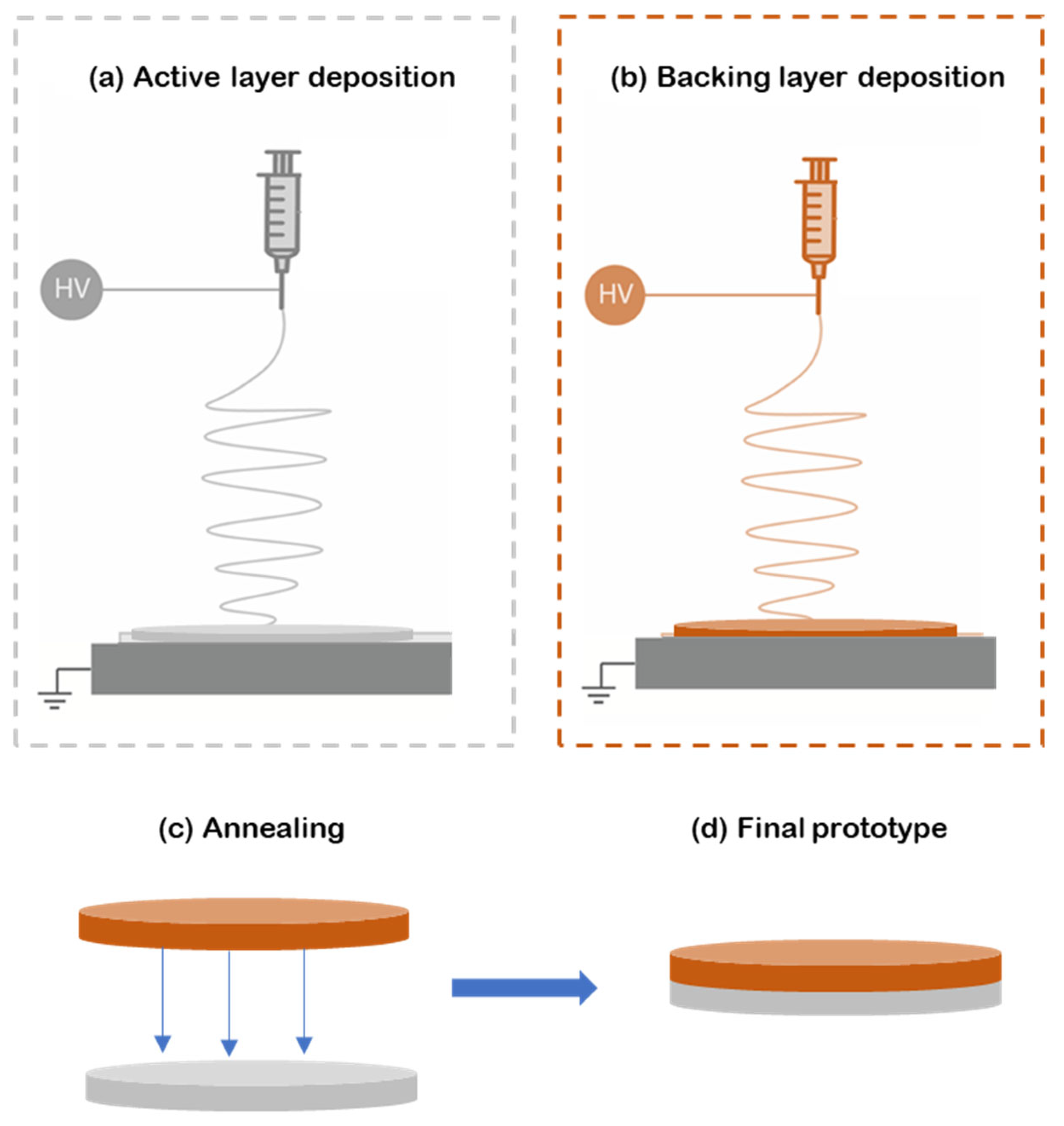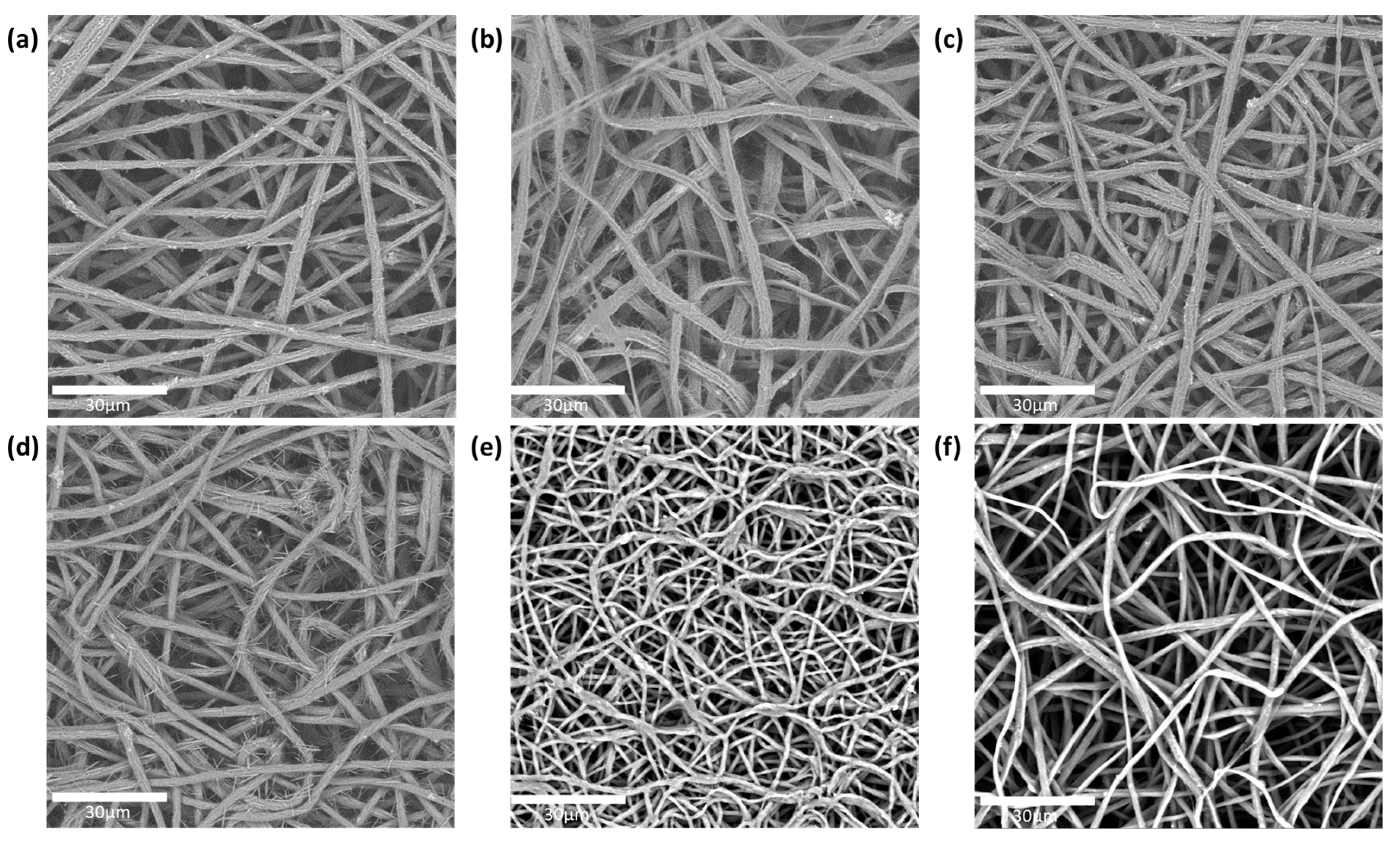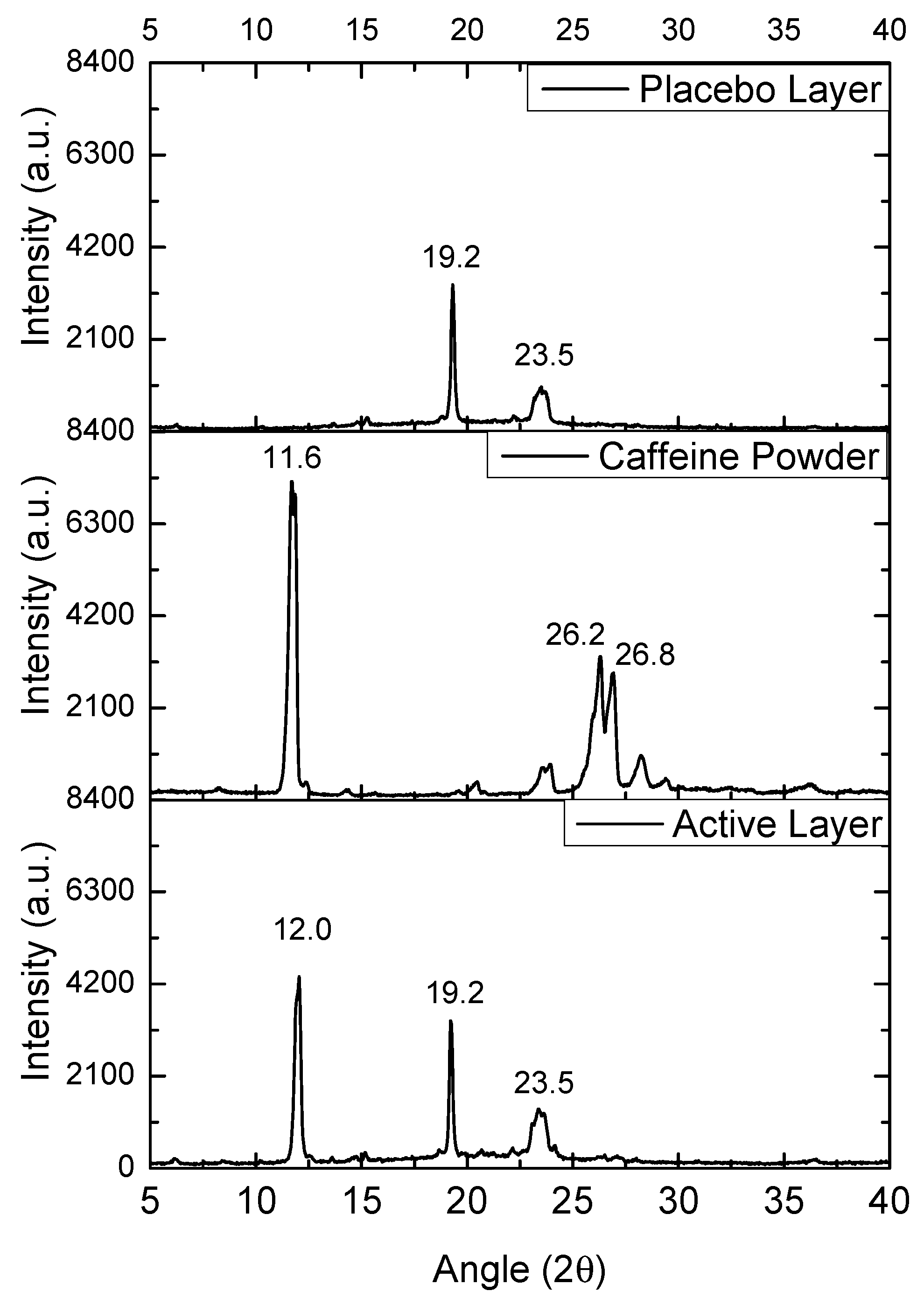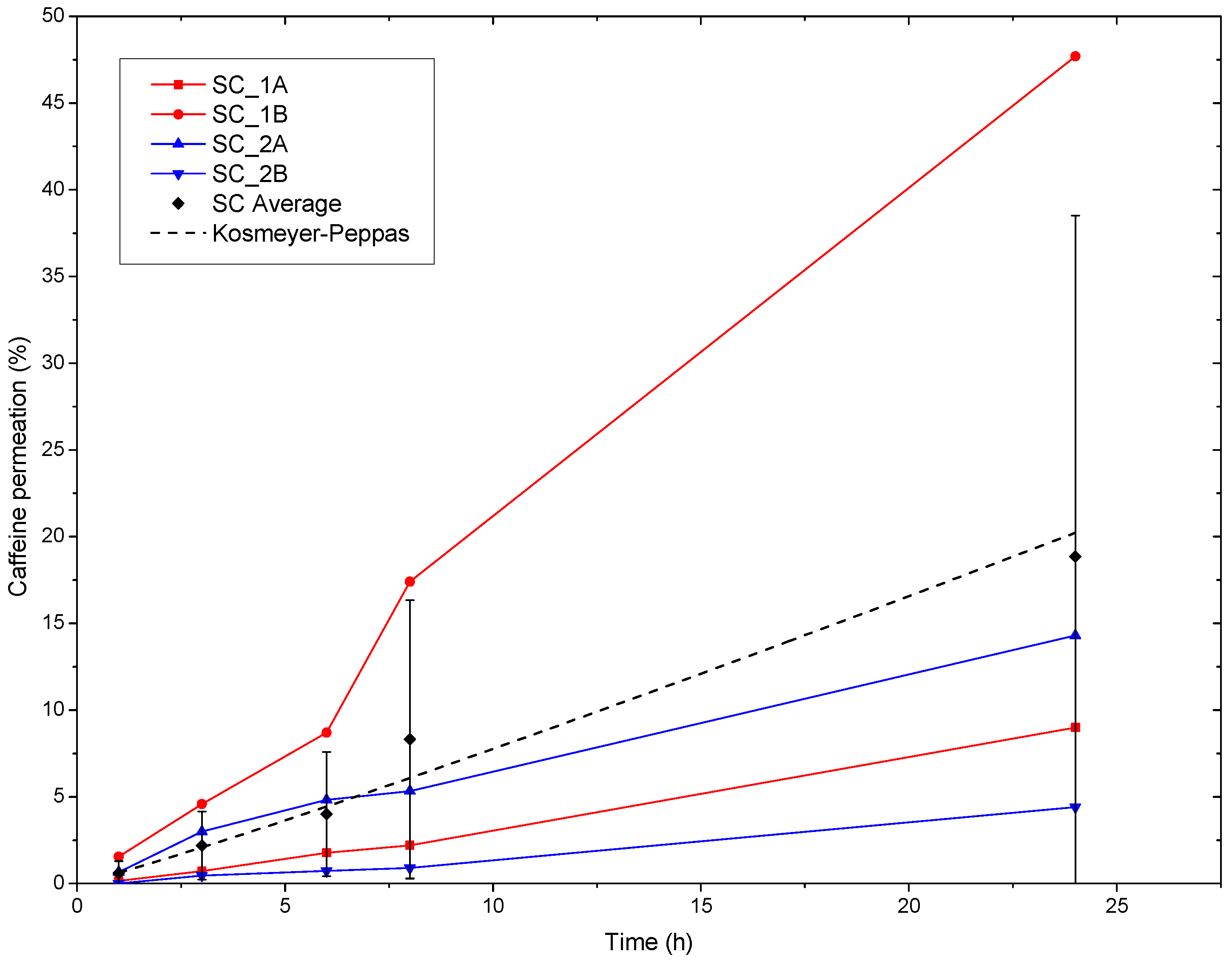The Development of a Multilayer Transdermal Patch Platform Based on Electrospun Nanofibers for the Delivery of Caffeine
Abstract
1. Introduction
2. Materials and Methods
2.1. Materials
2.2. Solution Preparation
2.3. Electrospinning
2.4. Human Skin Sample Preparation
2.5. Characterization
2.5.1. Fiber Morphology (SEM)
2.5.2. Assessment of In Vitro Release of Caffeine Patches Using Franz Diffusion Cell
2.5.3. Fourier Transform Infrared (FTIR) Spectroscopy
2.5.4. Differential Scanning Calorimetry (DSC)
2.5.5. Wide-Angle X-Ray Scattering (WAXS)
2.5.6. Kinetic Modeling of Ex Vivo Human Skin Permeation
3. Results and Discussion
3.1. The Fiber Morphology (SEM) of the Active Layer
3.2. The Effect of the Enhancer on the Permeation of Caffeine
3.3. Fourier Transform Infrared (FTIR) Spectroscopy
3.4. Differential Scanning Calorimetry (DSC)
3.5. Wide-Angle X-Ray Scattering (WAXS)
3.6. Ex Vivo Human SC Permeation and Modeling of Caffeine
4. Conclusions
Author Contributions
Funding
Institutional Review Board Statement
Informed Consent Statement
Data Availability Statement
Acknowledgments
Conflicts of Interest
References
- Ramadon, D.; McCrudden, M.T.C.; Courtenay, A.J.; Donnelly, R.F. Enhancement strategies for transdermal drug delivery systems: Current trends and applications. Drug Deliv. Transl. Res. 2022, 12, 758–791. [Google Scholar] [CrossRef]
- Shi, Y.; Xu, S.; Dong, A. Design and in vitro evaluation of transdermal patches based on ibuprofen-loaded electrospun fiber mats. J. Mater. Sci. Mater. Med. 2013, 24, 333–341. [Google Scholar] [CrossRef] [PubMed]
- Trommer, H.; Neubert, R.H.H. Overcoming the stratum corneum: The modulation of skin penetration. A review. Skin Pharmacol. Physiol. 2006, 19, 106–121. [Google Scholar] [CrossRef]
- van Smeden, J.; Janssens, M.; Gooris, G.S.; Bouwstra, J.A. The important role of stratum corneum lipids for the cutaneous barrier function. Biochim. Biophys. Acta Mol. Cell Biol. Lipids 2014, 1841, 295–313. [Google Scholar] [CrossRef]
- Moghadam, S.H.; Saliaj, E.; Wettig, S.D.; Dong, C.; Ivanova, M.V.; Huzil, J.T.; Foldvari, M. Effect of Chemical Permeation Enhancers on Stratum Corneum Barrier Lipid Organizational Structure and Interferon Alpha Permeability. Mol. Pharm. 2013, 10, 2248–2260. [Google Scholar] [CrossRef]
- Prausnitz, M.R.; Langer, R. Transdermal drug delivery. Nat. Biotechnol. 2008, 26, 1261–1268. [Google Scholar] [CrossRef]
- Kováčik, A.; Kopečná, M.; Vávrová, K. Permeation enhancers in transdermal drug delivery: Benefits and limitations. Expert Opin. Drug Deliv. 2020, 17, 145–155. [Google Scholar] [CrossRef]
- Dragicevic, N.; Maibach, H.I. Percutaneous penetration enhancers chemical methods in penetration enhancement: Modification of the stratum corneum. In Percutaneous Penetration Enhancers Chemical Methods in Penetration Enhancement; Springer: Berlin/Heidelberg, Germany, 2015; pp. 1–411. [Google Scholar] [CrossRef]
- Arellano, A.; Santoyo, S.; Martn, C.; Ygartua, P. Surfactant effects on the in vitro percutaneous absorption of diclofenac sodium. Eur. J. Drug Metab. Pharmacokinet. 1998, 23, 307–312. [Google Scholar] [CrossRef]
- Ibrahim, M.M.A.; Sammour, O.A.; Hammad, M.A.; Megrab, N.A. In vitro evaluation of proniosomes as a drug carrier for flurbiprofen. AAPS PharmSciTech 2008, 9, 782–790. [Google Scholar] [CrossRef]
- Xu, W.; Liu, C.; Zhang, Y.; Quan, P.; Yang, D.; Fang, L. An investigation on the effect of drug physicochemical properties on the enhancement strength of enhancer: The role of drug-skin-enhancer interactions. Int. J. Pharm. 2021, 607, 120945. [Google Scholar] [CrossRef]
- Schulz, M.; Fussnegger, B.; Bodmeier, R. Drug release and adhesive properties of crospovidone-containing matrix patches based on polyisobutene and acrylic adhesives. Eur. J. Pharm. Sci. 2010, 41, 675–684. [Google Scholar] [CrossRef]
- Teno, J.; Pardo-Figuerez, M.; Figueroa-Lopez, K.J.; Prieto, C.; Lagaron, J.M. Development of Multilayer Ciprofloxacin Hydrochloride Electrospun Patches for Buccal Drug Delivery. J. Funct. Biomater. 2022, 13, 170. [Google Scholar] [CrossRef]
- Pardo-Figuerez, M.; Teno, J.; Lafraya, A.; Prieto, C.; Lagaron, J.M. Development of an Electrospun Patch Platform Technology for the Delivery of Carvedilol in the Oral Mucosa. Nanomaterials 2022, 12, 438. [Google Scholar] [CrossRef] [PubMed]
- Patel, M.; Patel, A.; Desai, J.; Patel, S. Cutaneous Pharmacokinetics of Topically Applied Novel Dermatological Formulations. AAPS PharmSciTech 2024, 25, 1–18. [Google Scholar] [CrossRef] [PubMed]
- Kushwaha, R.; Palei, N.N. Transdermal Drug Delivery Systems: Different Generations and Dermatokinetic Assessment of Drug Concentration in Skin. Pharm. Med. 2024, 38, 407–427. [Google Scholar] [CrossRef] [PubMed]
- Gaydhane, M.K.; Sharma, C.S.; Majumdar, S. Electrospun nanofibres in drug delivery: Advances in controlled release strategies. RSC Adv. 2023, 13, 7312–7328. [Google Scholar] [CrossRef]
- Dziemidowicz, K.; Sang, Q.; Wu, J.; Zhang, Z.; Zhou, F.; Lagaron, J.M.; Mo, X.; Parker, G.J.M.; Yu, D.G.; Zhu, L.M.; et al. Electrospinning for healthcare: Recent advancements. J. Mater. Chem. B 2021, 9, 939–951. [Google Scholar] [CrossRef]
- Yu, D.G.; Shen, X.X.; Branford-White, C.; White, K.; Zhu, L.M.; Annie Bligh, S.W. Oral fast-dissolving drug delivery membranes prepared from electrospun polyvinylpyrrolidone ultrafine fibers. Nanotechnology 2009, 20, 055104. [Google Scholar] [CrossRef]
- Joiner, J.B.; Prasher, A.; Young, I.C.; Kim, J.; Shrivastava, R.; Maturavongsadit, P.; Benhabbour, S.R. Effects of Drug Physicochemical Properties on In-Situ Forming Implant Polymer Degradation and Drug Release Kinetics. Pharmaceutics 2022, 14, 1188. [Google Scholar] [CrossRef]
- Luraghi, A.; Peri, F.; Moroni, L. Electrospinning for drug delivery applications: A review. J. Control. Release 2021, 334, 463–484. [Google Scholar] [CrossRef]
- Pant, B.; Park, M.; Park, S.J. Drug delivery applications of core-sheath nanofibers prepared by coaxial electrospinning: A review. Pharmaceutics 2019, 11, 305. [Google Scholar] [CrossRef]
- Weiser, T.W. Caffeine as analgesic adjuvant. In Treatments, Mechanisms, and Adverse Reactions of Anesthetics and Analgesics; Elsevier: Amsterdam, The Netherlands, 2022; pp. 63–72. [Google Scholar]
- Sumedha, V.; Shiva, S.; Manikantan, S.; Ramakrishna, S. European Journal of Medicinal Chemistry Reports Pharmacology of caffeine and its effects on the human body. Eur. J. Med. Chem. Rep. 2024, 10, 100138. [Google Scholar] [CrossRef]
- Visconti, M.J.; Haidari, W.; Feldman, S.R. Therapeutic use of caffeine in dermatology: A literature review. J. Dermatol. Dermatol. Surg. 2020, 24, 18–24. [Google Scholar] [CrossRef]
- Herman, A.; Herman, A.P. Caffeine’s mechanisms of action and its cosmetic use. Skin Pharmacol. Physiol. 2012, 26, 8–14. [Google Scholar] [CrossRef]
- Avizheh, L.; Peirouvi, T.; Diba, K.; Fathi-Azarbayjani, A. Electrospun wound dressing as a promising tool for the therapeutic delivery of ascorbic acid and caffeine. Ther. Deliv. 2019, 10, 757–767. [Google Scholar] [CrossRef] [PubMed]
- Li, X.; Kanjwal, M.A.; Lin, L.; Chronakis, I.S. Electrospun polyvinyl-alcohol nanofibers as oral fast-dissolving delivery system of caffeine and riboflavin. Colloids Surf. B Biointerfaces 2013, 103, 182–188. [Google Scholar] [CrossRef] [PubMed]
- Illangakoon, U.E.; Gill, H.; Shearman, G.C.; Parhizkar, M.; Mahalingam, S.; Chatterton, N.P.; Williams, G.R. Fast dissolving paracetamol/caffeine nanofibers prepared by electrospinning. Int. J. Pharm. 2014, 477, 369–379. [Google Scholar] [CrossRef]
- Bruschi, M.L. (Ed.) Mathematical models of drug release. In Strategies to Modify the Drug Release from Pharmaceutical Systems; Elsevier: Berlin/Heidelberg, Germany, 2015; pp. 63–86. ISBN 9780081000922. [Google Scholar]
- Seif, S.; Franzen, L.; Windbergs, M. Overcoming drug crystallization in electrospun fibers-Elucidating key parameters and developing strategies for drug delivery. Int. J. Pharm. 2015, 478, 390–397. [Google Scholar] [CrossRef] [PubMed]
- Naik, A.; Pechtold, L.A.R.M.; Potts, R.O.; Guy, R.H. Mechanism of oleic acid-induced skin penetration enhancement in vivo in humans. J. Control. Release 1995, 37, 299–306. [Google Scholar] [CrossRef]
- Silvertein, R.M.; Webster, F.X.; Kiemle, D. Silverstein-Spectrometric Identification of Organic Compounds, 7th ed.; Wiley: Hoboken, NJ, USA, 2005; ISBN 0-471-39365-2. [Google Scholar]
- Sarfraz, A.; Simo, A.; Fenger, R.; Christen, W.; Rademann, K.; Panne, U.; Emmerling, F. Morphological Diversity of Caffeine on Surfaces: Needles and Hexagons. Cryst. Growth Des. 2011, 12, 583–588. [Google Scholar] [CrossRef]
- Eman, A.; Namjoshi, S.; Mohammed, Y.; Roberts, M.S.; Grice, J.E. Synergistic Skin Penetration Enhancer and Nanoemulsion Formulations Promote the Human Epidermal Permeation of Caffeine and Naproxen. J. Pharm. Sci. 2016, 105, 212–220. [Google Scholar] [CrossRef]


 without an enhancer,
without an enhancer,  oleic acid,
oleic acid,  polyethylene glycol,
polyethylene glycol,  polyethylene glycol and oleic acid,
polyethylene glycol and oleic acid,  propylene glycol and oleic acid, and
propylene glycol and oleic acid, and  polyethylene glycol and eucalyptol oil.
polyethylene glycol and eucalyptol oil.
 without an enhancer,
without an enhancer,  oleic acid,
oleic acid,  polyethylene glycol,
polyethylene glycol,  polyethylene glycol and oleic acid,
polyethylene glycol and oleic acid,  propylene glycol and oleic acid, and
propylene glycol and oleic acid, and  polyethylene glycol and eucalyptol oil.
polyethylene glycol and eucalyptol oil.




| Sample ID | Ratio of Polymer/API/Enhancer (w/w) | Solvents and Ratio (w/w) |
|---|---|---|
| PEO_CAF | 80/20 | Chloroform/MeOH (80:20) |
| PEO_CAF_OA | 70/20/10 | |
| PEO_CAF_PEG | 64/20/16 | |
| PEO_CAF_PG_OA | 56/20/14/10 | |
| PEO_CAF_PEG_OA | 56/20/14/10 | |
| PEO_CAF_PEG_EUC | 60/20/15/5 |
| Sample ID | Flow Rate (mL/h) | Voltage, V+/V− (kV) | Needle-to-Collector Distance (cm) |
|---|---|---|---|
| PEO_CAF | 10 | 20/−5 | 20 |
| PEO_CAF_OA | 10 | 20/−10 | 20 |
| PEO_CAF_PEG | 10 | 20/−10 | 20 |
| PEO_CAF_PG_OA | 10 | 20/−10 | 20 |
| PEO_CAF_PEG_OA | 10 | 20/−10 | 20 |
| PEO_CAF_PEG_EUC | 10 | 20/−10 | 20 |
| BL (PCL) | 20 | 15/−2 | 15 |
| Sample ID | Fiber Size (µm) | Caffeine at Fiber Surface |
|---|---|---|
| PEO_CAF | 2.1 ± 0.5 | Yes |
| PEO_CAF_OA | 2.8 ± 0.4 | Yes |
| PEO_CAF_PEG | 2.3 ± 0.4 | Yes |
| PEO_CAF_PG_OA | 2.2 ± 0.4 | Yes |
| PEO_CAF_PEG_OA | 1.1 ± 0.2 | No |
| PEO_CAF_PEG_EUC | 1.7 ± 0.2 | No |
| Sample ID | Initial Caffeine Content (mg/cm2) | Permeated Caffeine (mg/cm2) |
|---|---|---|
| PEO_CAF | 1.33 | 0.15 ± 0.01 |
| PEO_CAF_OA | 1.87 | 0.17 ± 0.02 |
| PEO_CAF_PEG | 1.85 | 0.31 ± 0.08 |
| PEO_CAF_PG_OA | 1.95 | 0.17 ± 0.04 |
| PEO_CAF_PEG_OA | 2.02 | 0.73 ± 0.02 |
| PEO_CAF_PEG_EUC | 1.69 | 0.41 ± 0.34 |
| ID | Korsmeyer–Peppas | ||
|---|---|---|---|
| K | n | r2 | |
| PCL + PEO_CAF_PEG_OA multilayer patch | 0.63 | 1.09 | 0.96 |
Disclaimer/Publisher’s Note: The statements, opinions and data contained in all publications are solely those of the individual author(s) and contributor(s) and not of MDPI and/or the editor(s). MDPI and/or the editor(s) disclaim responsibility for any injury to people or property resulting from any ideas, methods, instructions or products referred to in the content. |
© 2025 by the authors. Licensee MDPI, Basel, Switzerland. This article is an open access article distributed under the terms and conditions of the Creative Commons Attribution (CC BY) license (https://creativecommons.org/licenses/by/4.0/).
Share and Cite
Teno, J.; Evtoski, Z.; Prieto, C.; Lagaron, J.M. The Development of a Multilayer Transdermal Patch Platform Based on Electrospun Nanofibers for the Delivery of Caffeine. Pharmaceutics 2025, 17, 921. https://doi.org/10.3390/pharmaceutics17070921
Teno J, Evtoski Z, Prieto C, Lagaron JM. The Development of a Multilayer Transdermal Patch Platform Based on Electrospun Nanofibers for the Delivery of Caffeine. Pharmaceutics. 2025; 17(7):921. https://doi.org/10.3390/pharmaceutics17070921
Chicago/Turabian StyleTeno, Jorge, Zoran Evtoski, Cristina Prieto, and Jose M. Lagaron. 2025. "The Development of a Multilayer Transdermal Patch Platform Based on Electrospun Nanofibers for the Delivery of Caffeine" Pharmaceutics 17, no. 7: 921. https://doi.org/10.3390/pharmaceutics17070921
APA StyleTeno, J., Evtoski, Z., Prieto, C., & Lagaron, J. M. (2025). The Development of a Multilayer Transdermal Patch Platform Based on Electrospun Nanofibers for the Delivery of Caffeine. Pharmaceutics, 17(7), 921. https://doi.org/10.3390/pharmaceutics17070921









